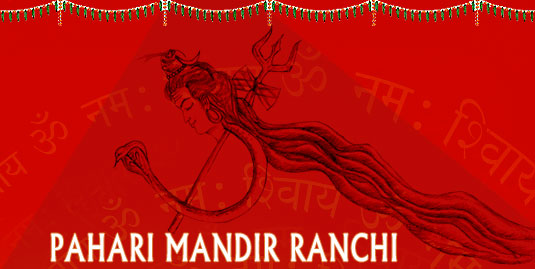|
Chants of ‘BOL-BUM’ and
the jingle of kanwars fill the morning air at the Pahari Mandir every
year on the days of the auspicious Shravani Mela.
A sea of saffron-clad pilgrims can be seen surging towards the Pahari
Temple after completing an arduous journey on foot. The Kanwariyas,
with pots of water balancing adroitly on their shoulders, both excited
and humble at their mission.
Some of the devotees come from far-flung areas. The pilgrims board
trekkers from their villages or towns and come to the Swarnarekha river at
Namkum. They walk from the river to the temple which is 12 km
long stretch.
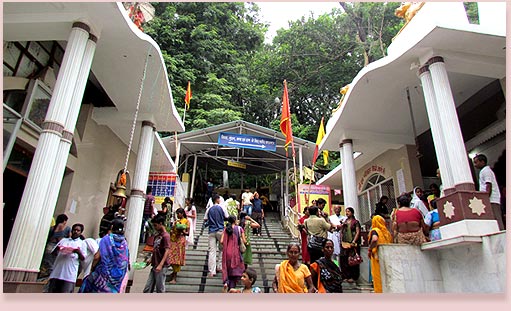 The Devotees don’t even feel the strain of the long walk because the
excitement of reaching the temple first which keeps them going. The entire
journey is very enjoyable for the devotees. The banks of the Swarnarekha
also buzz with activity that begins in the early hours of the night.
Devotees take a ritual bath under mast lights put up by local
volunteers. They then fill the earthen pitchers with water from the
river, and begin a walk that culminate only after the water is poured
on Lord Shiva.
The Ranchi Municipal Corporation (RMC) also arrange facilities for
the Shiva devotees, who comes from far places. The RMC cleans up the
roads leading to the temple. Water tankers are placed at the base of
the temple, while extra water carriers are provided everyday during
the mela. They make sure that the streetlights have been repaired
while new ones have been installed.
The volunteers of the temple take
care that the pilgrims or the devotees should not have any sort
problems .If some occur unfortunately they are always on- foot
to offer help to the victims. The Sukhdev Nagar Police Station, which is in charge of the area,
constitute a special security cell to ensure the safety of the Shiv
bhakts. A few women constables is also include in the cell.
The Pahari Mandir Samiti takes efficient measure to ensure that
Pilgrims are satisfied with the arrangements made by them.
|
| Maha Shivratri is
a Hindu festival celebrated every year in reverence of Lord Shiva.
Alternate common names/spellings include Maha Sivaratri,
Shivaratri, Sivarathri,. Shivaratri
literally means the great night of Shiva.
According to the mythology Shiva and Shakti married each
other. It is
celebrated every year on the 13th night/14th day of the Maagha or
Phalguna month of the Hindu calendar. The festival is principally
celebrated by offering Bael or Bilva/Vilvam leaves,
flowers, and other gifts on the Linga which is a symbol of Lord Siva,
and bathing it with milk, honey, butter, ghee,
rose-water, etc. All-day fasting and an all-night-long vigil.
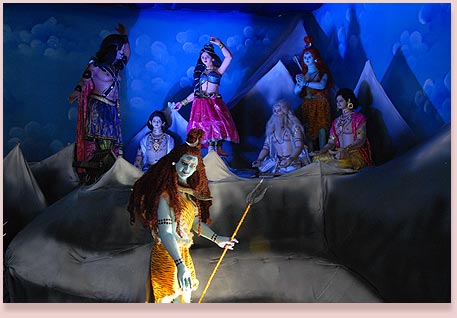
According to a legend, Parvati performed
tapasya, prayed and meditated on this day to ward off any evil that
might befall her husband on the moonless night. Since then, Mahashivaratri
is believed to be an auspicious occasion for Indian women to
pray for the well-being of their husbands and sons. Unmarried girls
prays for a husband alike Shiva, who is considered to be an ideal
husband.
In this auspicious day the sanctum sanctorum housing the deity was
altered time and again and finally gave way into a vivid impression. Canopies and Props are
been decorated like the
peoples of groom's side as this is the marriage day of Shiva and Parvati. The canopies and props came down from the hill of the
Pahari Mandir to go round the city in a procession as Barati where the
Chief Minister, Deputy Chief Minister and many more VIP's felicitate the
Barati's. After the round about in the city the barati's visit to a temple
near to the Pahari Mandir to perform the marriage of the
gods which is a grand celebration. The important features of this
religious function are rigid fasting for twentyfour hours and
sleepless vigil during the night. Every true devotee of Lord Siva
spend the night of Sivaratri in deep meditation, keeps vigil and
observes fast.
From the very
early morning, Pahari Mandir is flocked by devotees, young and
old, who come to perform the traditional Shivalinga worship (puja)
and hence hope for favours from the god. The temple reverberates
with the sound of bells and shouts of “Shankerji ki Jai”
meaning 'Om Namah Shiva'. They observe strict spiritual
discipline in the day and worships Lord Shiva in four different
forms in the four successive Praharas, each made up of three
hours of the night. The offering of a few Bilva leaves is more
precious to Lord Shiva than the precious jewels and flowers.They
bathe the Lord in milk at the first Prahara, in curd at the
second, in clarified butter at the third, and in honey at the
fourth and last. Next morning, then they feed the Brahmins first
and break the fast after the performance of the prescribed
ceremonies. There is no ritual which can compare with this
simple routine in sanctity.
|
|
Varshik
Mahotsava or Annual Ritual is celebrated every year in December. A huge amount of
Devotees gather here on this auspicious occasion. The deity of
Lord Shiva came out from a sea-shell which is duely
ornamented
with flowers. In this day the premise of the temple is also
embellished with flowers. Lord Shiva is been offered with
Chhapan Bhog .
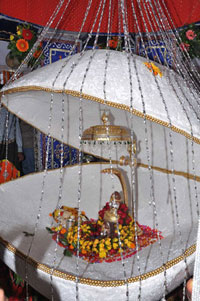
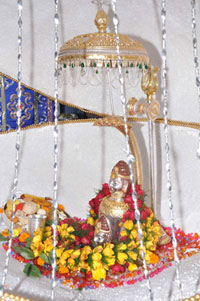
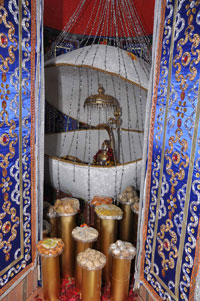
Whole through the day Bhajans
or the song of god is been played inside the temple which make the
aura very pious. Different props of gods and goddesses are been displayed.
The live props
plays drama mimicking some mythological story. To visualize all this
thousands of devotees from all caste and Crete from different parts of the state gathers here to make this
celebration a grand one.
|
|
The people of Ranchi have a unique way of remembering the heroes who
sacrificed their lives during the freedom struggle. It is said many
freedom fighters were sent to the gallows atop this hill. When the
country won freedom, the residents of Ranchi, decided to pay respect
to those martyrs by hoisting the tricolor on the hill. And the
tradition continues with people hosting the tricolor during
Independence and Republic Day atop the temple as a mark of respect
towards those who sacrificed their lives. This is a unique gesture
found at a temple, which is very rare and special.
National Flag is unfurled here virtually
right on the stroke of midnight, this temple naturally comes to hold
some special significance. |
